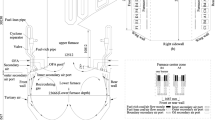Abstract
The progression of ignition was numerically simulated with the aim of realizing a full-scale tiny-oil ignition burner that is identical to the burner used in an 800MWe utility boiler. The numerical simulations were conducted for four excess air ratios, 0.56, 0.75, 0.98 and 1.14 (corresponding to primary air velocities of 17, 23, 30 and 35 m/s, respectively), which were chosen because they had been used previously in practical experiments. The numerical simulations agreed well with the experimental results, which demonstrate the suitability of the model used in the calculations. The gas temperatures were high along the center line of the burner for the four excess air ratios. The flame spread to the burner wall and the high-temperature region was enlarged in the radial direction along the primary air flow direction. The O2 concentrations for the four excess air ratios were 0.5%, 1.1%, 0.9% and 3.0% at the exit of the second combustion chamber. The CO peak concentration was very high with values of 7.9%, 9.9%, 11.3% and 10.6% for the four excess air ratios at the exit of the second combustion chamber.
Similar content being viewed by others
References
Liu C L, Li Z Q, Zhao Y, Chen Z C. Influence of coal-feed rates on bituminous coal ignition in a full-scale tiny-oil ignition burner. Fuel, 2010, 89(7): 1690–1694
Li Z Q, Liu C L, Zhao Y, Chen Z C. Influence of the coal-feed rate on lean coal ignition in a full-scale tiny-oil ignition burner. Energy & Fuels, 2010, 24(1): 375–378
Liu C L, Li Z Q, Kong W G, Zhao Y, Chen Z C. Influence of the excess air ratio on bituminous coal combustion in a full-scale startup ignition burner. Energy, 2010, 35(10): 4102–4106
Li Z Q, Liu C L, Zhu Q Y, Kong W G, Zhao Y, Chen Z C. Experimental studies on the effect of the pulverized coal concentration on lean-coal combustion in a lateral-ignition tiny-oil burner. Energy & Fuels, 2010, 24(8): 4161–4165
Zeng L Y, Li Z Q, Cui H, Zhang F C, Chen Z C, Zhao G B. Effect of the fuel bias distribution in the primary air nozzle on the slagging near a swirl coal burner throat. Energy & Fuels, 2009, 23(10): 4893–4899
Vuthaluru H B, Vuthaluru R. Control of ash related problems in a large scale tangentially fired boiler using CFD modeling. Applied Energy, 2010, 87(4): 1418–1426
Li Z Q, Jing J P, Ge Z H, Liu G K, Chen Z C, Ren F. Numerical simulation of low NOx combustion technology in a 100MWe bituminous coal-fired wall boiler. Numerical Heat Transfer. Part A: Applications, 2009, 55(6): 574–593
Diez L I, Cortes C, Pallares J. Numerical investigation of NOx emissions from a tangentially-fired utility boiler under conventional and overfire air operation. Fuel, 2008, 87(7): 1259–1269
Sheng C, Moghtaderi B, Gupta R, Wall T F. A computational fluid dynamics based study of the combustion characteristic of coal blends in pulverized coal-fired furnace. Fuel, 2004, 83(11,12): 1543–1552
Backreedy R I, Jones J M, Ma L, Pourkashanian M, Williams A, Arenillas A, Arias B, Pis J J, Rubiera F. Prediction of unburned carbon and NOx in a tangentially fired power station using single coals and blends. Fuel, 2005, 84(17): 2196–2203
Li L M, Chen L Z, Sun R, Li B Y, Li W B, Guo A G, Diao Y F. Numerical simulation and industrial application of combustion process of horizontal bias less-oil ignited pulverized-coal burner. Electric Power Construction, 2008, 29(8): 7–12
Li X M, Yao L, Li C T. Numerical simulation of ignition with less oil in abundant oxygen. Power System Engineering, 2008, 24(1): 19–23
Fu Z G, Wang Z P, Shi L L. Numerical simulation of the tiny-oil ignition burner in the coal fired boiler. Journal of Engineering Thermophysics, 2008, 29(4): 609–612 (in Chinese)
Shih T H, Liou W W, Shabbir A, Shabbir A, Yang Z G, Zhu J. A new k-ɛ eddy viscosity model for high reynolds number turbulent flows-model development and validation. Computers & Fluids, 1995, 24(3): 227–238
Gosman A D, Loannides E. Aspects of computer simulation of liquid-fuelled combustors. Journal of Energy, 1983, 7(6): 482–490
Cheng P. Two-dimensional radiation gas flow by a moment method. AIAA Journal, 1964, 2(3): 1662–1664
Smoot L D, Smith P J. Coal Combustion and Gasification. New York: Plenum Press, 1985
Spalding D B. Combustion and Mass Transfer. New York: Pergamon Press, 1979
Zhou L X. Theory and Numerical Modeling of Turbulent Gas-Particle Flows and Combustion. England: CRC Press, 1993
Author information
Authors and Affiliations
Corresponding author
Rights and permissions
About this article
Cite this article
Li, Z., Liu, C., Zhang, X. et al. Numerical simulation of bituminous coal combustion in a fullscale tiny-oil ignition burner: Influence of excess air ratio. Front. Energy 6, 296–303 (2012). https://doi.org/10.1007/s11708-012-0191-0
Received:
Accepted:
Published:
Issue Date:
DOI: https://doi.org/10.1007/s11708-012-0191-0



